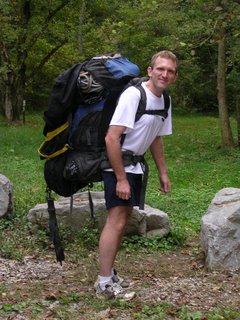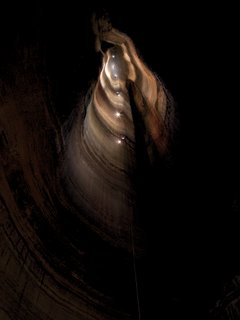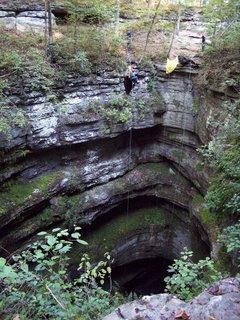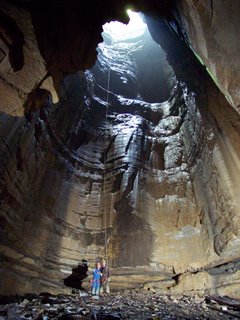On Oct. 5 - 8, Brian Masney, Mary Schmidt, Judi Wasilewski, and Dave Riggs took a trip down to
TAG to drop some classic pits. Our original plan was to photograph Fantastic Pit then head to the
TAG Fall Cave-In, but we decided to skip the Cave-In entirely and squeeze in as much caving as possible instead.
We hit the road from Morgantown at about 2pm on Thursday and headed South. We met Judi in VA, and then headed down to the tip of Georgia. We finally pulled into the
Crockford Pigeon Mountain Wildlife Reserve just after midnight, set up camp and went to bed.
Day 1: Ellison's CaveWe woke up early Friday morning and gathered up all our caving gear. A second, larger caving group showed up as we were getting ready to leave, but they were a
bit less organized than we were. The trail up to Ellison's Cave starts down at Blue Hole, the cave's resurgence. The hike is over a mile uphill, and this hike is exhausting when you're loaded down with gear and rope.
 Brian ready to hike up Pigeon Mountain with 900' of rope in tow
Brian ready to hike up Pigeon Mountain with 900' of rope in tow Brian, Mary, Judi, and Dave at the entrance to Ellison's Cave
Brian, Mary, Judi, and Dave at the entrance to Ellison's CaveWe reached the unimpressive crack-in-the-ground which is the preferred entrance to do Fantastic Pit and got dressed. After a climb-down, the cave consists of nice walking stream passage (very dry this day) called The Ecstasy, which leads to the 120' Warm-Up Pit. We rigged from a couple bolts in the ceiling and ran our rope through some deep rope grooves worn into the rock, no rope pad necessary -- hooray for
PMI. From the Warm-Up Pit, you head up a few nuisance climbs, then to a 20' ascent. From here, it's a short path to a traverse line under a short ledge to The Attic, looking out over Fantastic Pit.
Fantastic Pit is the deepest known pit in the Continental US, a 586' free rappel down a beautiful vertical-walled shaft. We rigged our 900' rope to a massive boulder, tied a knot in the end, then lowered most of it down using a rack to keep it at a safe speed. Brian repelled down first, occasionally shouting or whistling to hear the amazing echo. All of a sudden we heard him shout "
F@#%!" and everything went quiet as we all felt our stomachs sink... Brian radioed up that he was hanging 40' off the floor but had reached the knot at the end of the rope. We'd just barely short-rigged the pit. Rather than risk being lowered from above, he changed over and ascended back up. Even though his
foot ascender broke on the way, he still made it to the top in what seemed like record time.
We re-rigged the rope, and this time I was the
guinea pig to try it out. The ride down seemed to take forever, and the amazing reverberating echo from the pit was absolutely haunting. I finally reached the bottom of the shaft, got off rope, and discovered that my cheap radio no longer worked. Communication from top to bottom is practically impossible without one, and Judi was halfway to the bottom before I knew for sure that she was on rope! One by one, the rest of our team made it to the bottom and got ready for a long wait and a long ascent. I was the first to ascend back out, and was admittedly nervous about it. Not only would I be the first one up our only rope, the biggest ascent I'd ever attempted, but I'd be also be helping Brian photograph the pit by firing off several flashes on the way up.
Brian gave me a quick lesson in the operation of a
flashbulb. I was to screw the bulb into the trigger without looking at it, wait for the signal, then look the other way with my eyes closed and fire the unit away from me to ensure that I didn't lose my sight. Oh, and I should also be careful since they sometimes explode if they come in contact with water.
Great. I started frogging up at a very slow pace -- the rope would bounce more than 10' with each stride. Every 30 or 40 strides I'd stop and dig through my duffel bag trying to find a fresh flashbulb, arm it, and fire off a shot for the camera. Even with all the breaks, I managed to get incredibly hot and dehydrated. The climb seemed like it took hours.
 A composite of 10 different individual photos and the result of hours and hours of cave photography, Brian's photo of Fantastic still can't do justice to how enormous this pit is.
A composite of 10 different individual photos and the result of hours and hours of cave photography, Brian's photo of Fantastic still can't do justice to how enormous this pit is.Judi headed up next, also armed with a few flashbulbs to light up the rest of the pit. She and Mary flew to the top with their ropewalkers, then Brian frogged back up a second time loaded with all his photography gear! Pulling the rope back up was a huge effort, as was hauling the damn thing back out of the cave -- it's amazing how much your rope and gear expands when you're trying to get back out of a cave. Back down the nuisance drop with that monster rope, and then back up the Warm-Up pit, and then derigging the Warm-Up pit, and then hauling everything back out... we were exhausted, and not looking forward to the hike back down the mountain. We opted to dump our ropes at the cave entrance and hike down lightly, a hike that seemed to have doubled in length since the previous morning. We finally made it back to camp at 4am, after a long but incredible day of caving. After a good breakfast in the morning, the hike to retrieve our ropes seemed like a piece of cake. We found a fraction of the other caving group getting ready to go back in, they had showed up to finally rappel Fantastic -- they'd run out of time the previous day and half of their group had abandoned the trip; the poor remaining three cavers would have to haul the entire party's gear and ropes back out on their own!
Day 2: Neversink PitWe left Georgia that afternoon and headed to Alabama to drop another TAG classic, the 162' Neversink Pit. We took a quick detour to check out the nearby
rock zoo, then parked and geared up. Everyone hiked up the hill and found over a dozen cavers there -- TAG Fall Cave-In traffic.
 Beautiful view of Neversink Pit
Beautiful view of Neversink PitWe waited for a good rigging spot to open up, rigged to a tree and waited some more. Finally enough people were out of the way that we could rappel down with our rope. This pit is gorgeous. It's an open-air pit where the sun shines down in, the layered walls are covered with moss and ferns and small waterfalls. We were all able to get to the bottom before the sun set and were treated to an incredible view. This pit seemed tiny after doing Fantastic the day before! After Neversink, we headed to a nearby camping site, complete with bathrooms and hot showers.
Day 3: Cagles ChasmSunday we opted to squeeze in one more pit before heading home; we drove to Tennessee for Cagles Chasm. We parked next to a kennel full of barking beagles and got geared up. Time for another hike up another hill, but at least this one was an easy one.
 Mary Schmidt rapells into Cagles Chasm
Mary Schmidt rapells into Cagles ChasmCagles Chasm is another open-air pit, a 186' vertical shaft which intersects a maze of cave passages on the way down. The view from the bottom looking up is spectacular, especially if you're a geology fan (you are,
right?). With no traffic to contend with this time, we bounced the pit quickly and were ready for the drive back home by late afternoon.
 Judi and Dave at the bottom of Cagles Chasm
Judi and Dave at the bottom of Cagles ChasmWe made it back to Morgantown by 2am Sunday, after a great weekend full of amazing pits. Everyone was glad that we'd opted to skip the Cave-In to squeeze in more actual caving. After visiting these TAG classics, it's easy to see why this area is the best vertical caving in the country!
All photos by Brian MasneySee:
Brian's trip photosSee:
My trip photos








